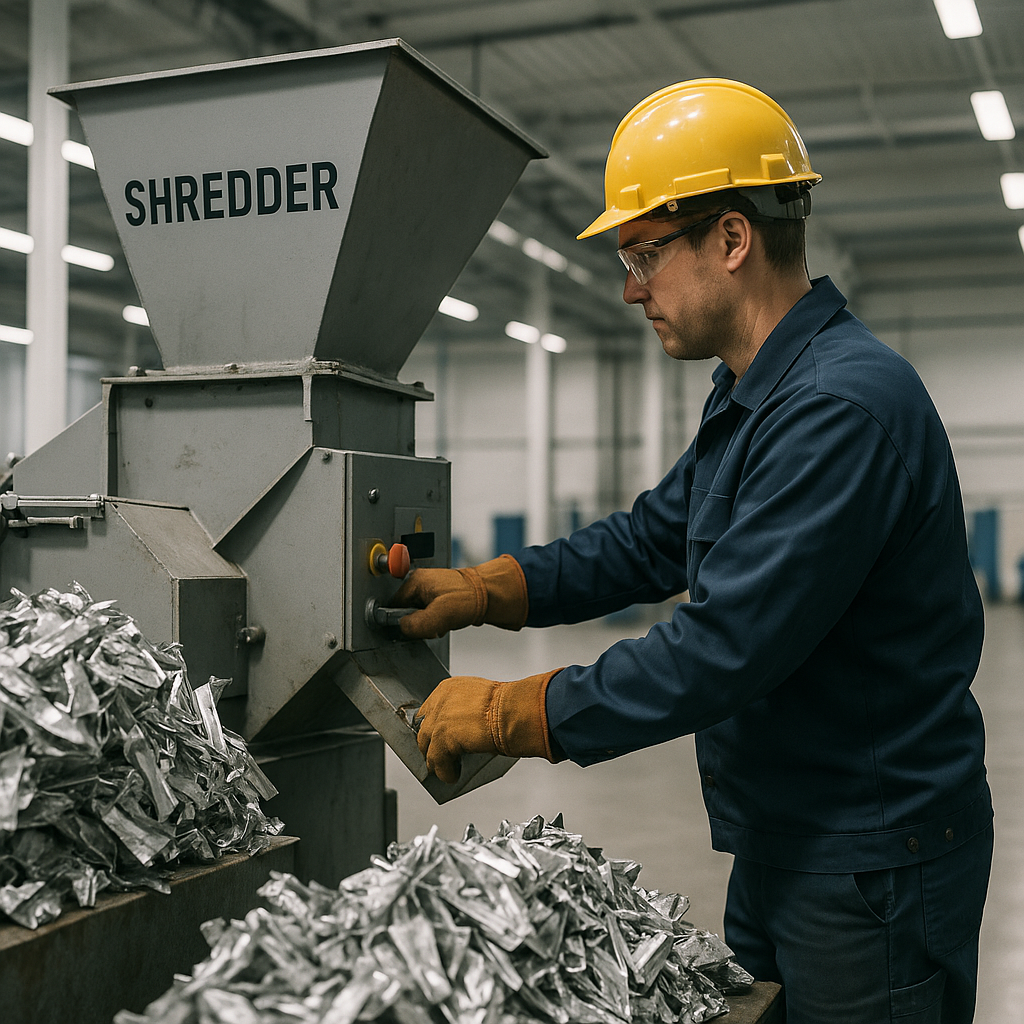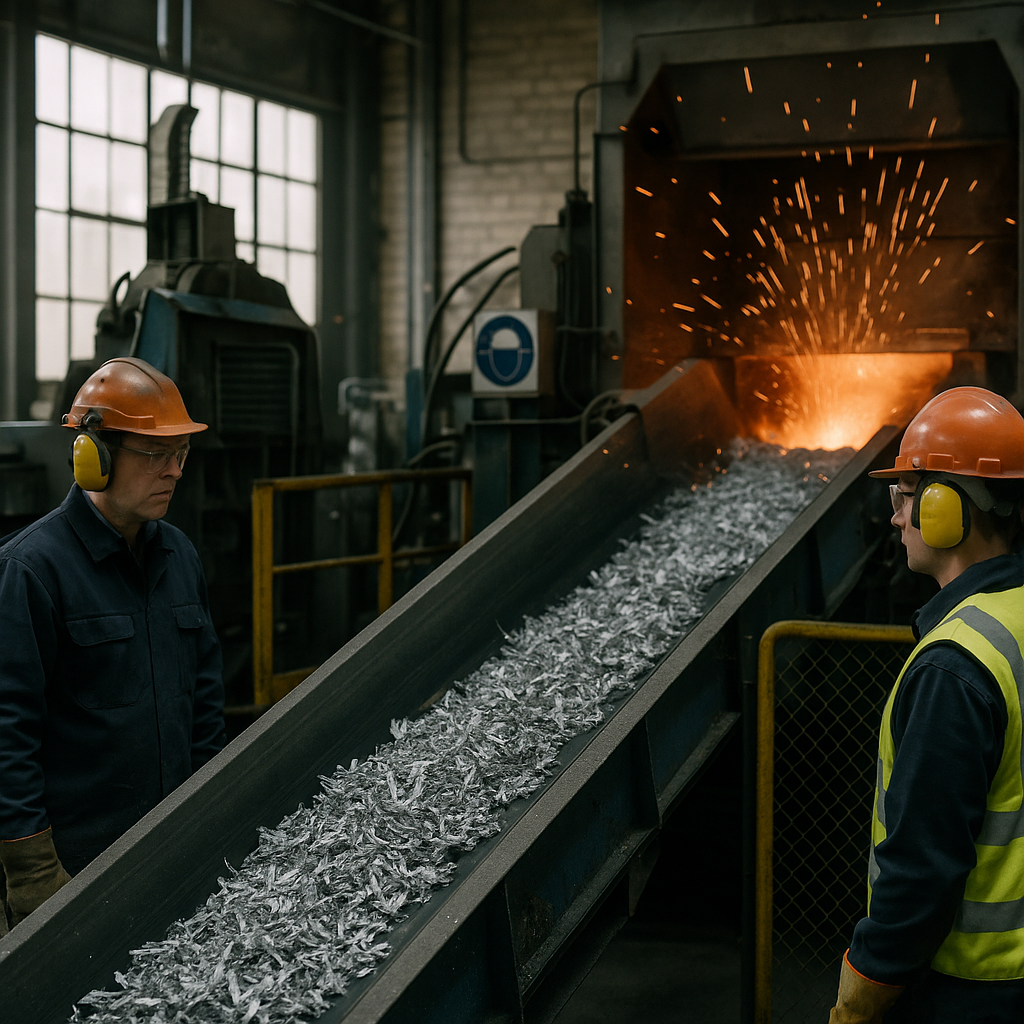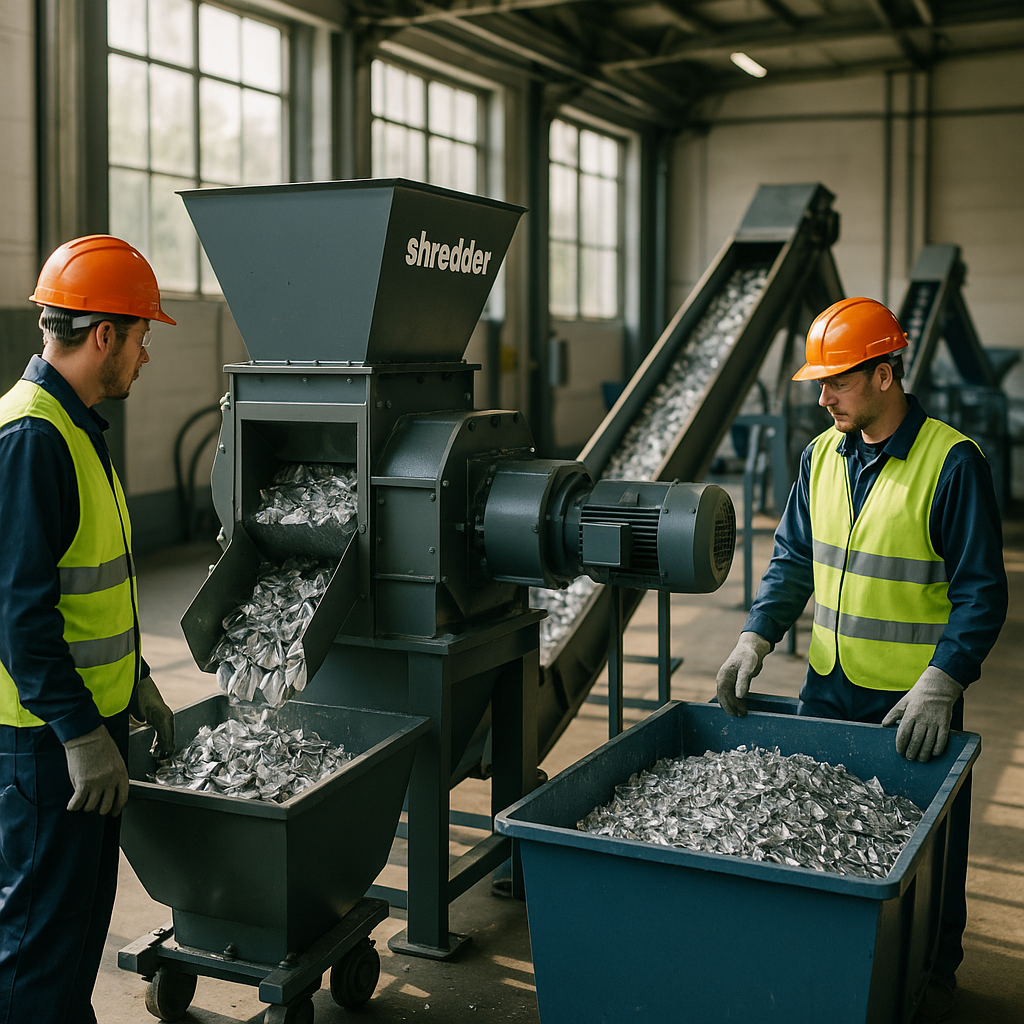5901 Botham Jean Blvd, Dallas, TX 75215
Aluminum Shredding: Process, Benefits, Recycling Steps, and Future of Sustainability
October 2, 2025Aluminum shredding transforms bulky metal scrap into smaller, uniform pieces using specialized industrial machinery. This crucial process breaks down everything from discarded beverage cans to automotive components into manageable fragments for efficient further processing. Without this vital first step, aluminum recycling would be far less effective.
The significance of aluminum shredding extends beyond simple size reduction. This process is foundational for efficient metal recovery by making the material easier to sort, clean, and prepare for melting. Modern shredders use powerful rotating hammers, blades, or cutting mechanisms to process both clean aluminum and mixed metal scrap.
Aluminum recycling rates highlight the importance of effective shredding. In the United States, approximately 45% of aluminum is recycled, while countries like Germany achieve an impressive 99% recycling rate for aluminum beverage containers. This gap represents billions in lost value and a significant environmental impact that proper shredding infrastructure could help address.
What are the Benefits of Using Aluminum Shredding Machines?

Aluminum shredding machines have transformed metal recycling operations globally. These machines offer significant advantages for recycling facilities, metal processors, and the environment. Let’s examine the key benefits that make these machines indispensable in modern recycling operations.
Increased Processing Efficiency
Aluminum shredding machines significantly boost processing throughput compared to traditional methods. Modern shredders can handle several tons of aluminum scrap per hour, allowing facilities to process larger quantities in less time.
The uniform size reduction also streamlines downstream processes. Consistently shredding aluminum to specific dimensions enhances the effectiveness of sorting systems, eliminating bottlenecks and ensuring smoother material flow throughout the facility.
Rotary shredders have become the industry standard, replacing older hammermill methods. They provide more controlled size reduction with fewer mechanical issues, producing cleaner cuts with minimal dust.
Cost Reduction
Implementing aluminum shredding technology results in measurable financial benefits. Automated shredding systems reduce labor costs, as fewer workers are needed to handle material. One operator can manage volumes that previously required multiple workers.
Transportation expenses also decline. Shredded aluminum occupies less space than unprocessed scrap, allowing more material per shipment. This reduces fuel consumption and the number of required trips.
Maintenance costs often decrease with modern shredders, which feature replaceable cutting components and easy access points for servicing. These improvements reduce downtime and extend equipment lifespan.
Improved Material Recovery
Shredding machines excel at liberating valuable materials from complex scrap, naturally detaching non-metallic components like plastics and rubber. This separation is crucial for producing high-purity recycled metal.
The technology also exposes clean metal surfaces during processing. For rotary furnaces handling dross and lower-grade scrap, this improves flux efficiency and metal recovery rates, as clean surfaces interact better with processing chemicals.
Proper shredding can enhance recovery rates by 5-15% over unprocessed scrap, directly benefiting the bottom line of recycling operations.
Sustainability
The environmental benefits of aluminum shredding machines are substantial. Recycling aluminum uses only 5% of the energy needed to produce new aluminum from bauxite ore. Efficient shredding maximizes this energy saving.
Shredding reduces aluminum scrap volume by 60-80%, significantly decreasing landfill requirements and disposal costs.
Carbon emissions decrease throughout the supply chain. Efficient shredding reduces the need for energy-intensive primary aluminum production, preventing approximately 9 tons of CO₂ emissions per recycled ton.
Supporting the Circular Economy
Aluminum shredding technology is vital for circular economy principles, transforming end-of-life products into raw materials for new manufacturing, and keeping resources in continuous use.
The automotive industry benefits greatly, as modern vehicles increasingly use aluminum to reduce weight. Shredding allows this metal to be recovered and reused for new components.
Recycling facilities using advanced shredders can process diverse aluminum sources, from beverage cans to building materials, supporting multiple recycling streams and strengthening the entire infrastructure.
Safety Improvements
Modern shredders feature advanced safety measures, with enclosed cutting chambers and automated feeding systems to minimize direct contact with machinery.
Proper shredding systems also reduce fire risks, as specialized designs for aluminum processing lower friction and heat generation. Many units include temperature monitoring and automatic shutdown for safety.
Dust generation is better controlled in current designs, protecting workers from the respiratory hazards of metal particulates. Integrated dust collection systems capture fine particles before they become airborne.
Quality and Consistency
Shredding machines produce more consistent material, crucial for downstream processes like melting and refining. Furnaces operate more efficiently with consistent material, reducing energy consumption during smelting.
Product quality improves with properly shredded aluminum, as consistent particle size leads to more thorough contamination removal, producing higher-grade recycled aluminum.
The controlled processing environment reduces oxidation losses. Cleanly sheared aluminum exposes less surface area to oxidation, preserving more valuable metal content during recycling.
How is Shredded Aluminum Processed Further?

Once aluminum scrap has been shredded into smaller fragments, it undergoes a multi-stage process that transforms it from mixed metal pieces into valuable recycled material. This transformation involves specialized techniques to ensure the final product meets manufacturing quality standards.
Material Separation and Sorting
The first vital step after shredding is separating aluminum from other materials. Modern recycling facilities use several sophisticated sorting technologies to achieve efficient separation.
Magnetic separation is typically the initial method. Large magnets extract ferrous metals like steel and iron from the shredded material. Since aluminum is non-magnetic, it passes through this stage unaffected while ferrous contaminants are removed for separate recycling streams.
After magnetic separation, the material moves to eddy current separators. These machines use rapidly alternating magnetic fields to create electrical currents within non-ferrous metals. Essentially, this makes aluminum pieces jump away from non-metallic materials, allowing precise separation from plastics, rubber, and other non-conductive materials.
For higher-quality sorting, some facilities use sensor-based technologies. X-ray transmission systems can detect different aluminum alloys based on their atomic density, separating high-grade aluminum from lower-quality variants. Advanced recycling operations might also employ laser-induced breakdown spectroscopy to analyze the chemical composition of each piece for ultra-precise sorting.
The Melting Process
Once sorted, the clean aluminum fragments are moved to specialized furnaces for melting. The type of furnace used depends on the quality of scrap and desired output.
Reverberatory furnaces are common in large-scale operations. They can handle mixed aluminum scraps but work most efficiently when materials are pre-shredded to ensure consistent size. These furnaces use reflected heat from the roof and walls to efficiently melt the aluminum.
Rotary furnaces are often used for processing lower-grade scraps and dross. The rotating action helps expose clean metal surfaces, improving the efficiency of flux additions that capture impurities.
Induction furnaces require high-purity aluminum and are sensitive to contamination. These furnaces use electromagnetic induction to generate heat directly within the metal, making precise shredding and sorting essential for uniform melting.
Purification and Refining
During melting, various techniques remove remaining impurities. This purification stage is crucial for meeting quality standards.
Flux treatment involves adding chemicals to the molten aluminum that bind with impurities, forming compounds that float to the surface as dross, which is skimmed off. Common fluxes include chloride and fluoride salts that effectively capture oxides and other contaminants.
Gas purging introduces inert gases like nitrogen or argon into the molten metal. These gases rise through the liquid aluminum, attracting impurities as they bubble upward, helping remove hydrogen, which can cause porosity in the final product.
For applications requiring extremely high purity, some facilities use electrolytic refining, which employs an electric current to separate aluminum from impurities, achieving purity levels exceeding 99.9%.
Solidification and Casting
The final stage transforms molten aluminum into usable forms for manufacturing. After purification, the liquid metal moves to casting stations where it solidifies into various shapes.
Ingot casting is the most common method. The molten aluminum is poured into molds to create solid rectangular blocks called ingots. These standardized forms make transportation and further processing more efficient. Ingots typically weigh between 20-25 pounds, though larger sow ingots can weigh several hundred pounds.
For immediate use in manufacturing, some recycling operations cast aluminum directly into sheets, rods, or specific shapes per customer requirements. This direct-to-form casting saves additional processing steps and energy.
The cooling process requires careful temperature control to ensure proper crystallization and material properties. Too rapid cooling can create internal stresses, while too slow cooling might allow unwanted compounds to form.
Quality Control and Testing
Before shipment to manufacturers, the recycled aluminum undergoes rigorous testing to verify its composition and physical properties. Spectrometric analysis determines the exact alloy composition, ensuring it meets specifications for its intended use.
The quality of the input scrap directly affects the quality of the final product. Clean, well-sorted aluminum, like beverage cans, can be recycled into new cans, while mixed automotive scrap typically becomes casting alloys for engine blocks or wheels, where slight variations in composition are more tolerable.
Through these comprehensive processing steps, shredded aluminum transforms from waste into a valuable material that requires only 5% of the energy needed to produce new aluminum from bauxite ore. This remarkable efficiency makes aluminum recycling one of the most environmentally beneficial processes available.
Conclusion: The Future of Aluminum Shredding and Recycling

Aluminum shredding technology is a cornerstone of contemporary recycling operations, essential for resource conservation and environmental sustainability. Innovations in automated sorting, including AI-driven systems, advanced optical sorting, and LIBS processes, are redefining possibilities in aluminum recycling. These technologies enhance the precise separation of different aluminum alloys, significantly improving quality and efficiency.
The circular economy principles driving these advancements envision a future where aluminum can be recycled indefinitely without quality loss. With global aluminum demand expected to rise by 50% by 2030, efficient shredding and recycling processes are crucial. The substantial energy savings—up to 95% compared to primary production—make aluminum recycling both environmentally responsible and economically compelling in a world increasingly focused on reducing carbon emissions.
For your aluminum recycling needs, contact Okon Recycling at 214-717-4083.
